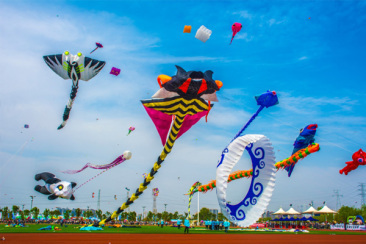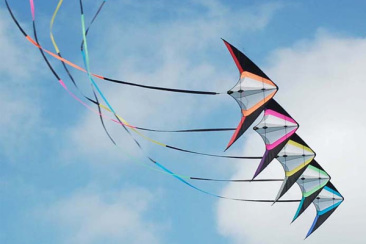The Development History of Kite Culture
Mozi (Mozi Zhai) passed on the kite making business to his student Lu Ban (also known as the Public Transport Class). According to Mozi's "Lu Wen Pian", Lu Ban made kites using bamboo based on Mozi Zhai's ideals and designs. Lu Ban sliced and smoothed the bamboo, baked and bent it with fire, and made it look like a magpie, called the "wooden magpie", which flew in the air for three days. The Book says, "The public transportation team made wooden kites to glimpse the city of Song." There are generally three legends about the origin of kites: bamboo hats, leaves, and sails. Legend has it that the first kite was made by "Lu Ban" and called "Mu Yuan". The "Old Stories of Zhugong" records that Lu Ban "tasted a wooden kite and used it to glimpse the city of Song". And according to the "L ü shi Chunqiu · Ai Lei", "Gongshu Ban was a high cloud ladder, intending to attack the Song Dynasty. Mozi heard of it and traveled from Lu, tearing his clothes and wrapping his feet, day and night without stopping. Ten days and ten nights later, when he arrived in Ying, he saw King Jing and said, 'I, the humble people in the north, have heard that the king will attack the Song Dynasty, and I believe it.'" This indicates that Lu Ban built the "high cloud ladder" instead of wooden kites at that time.
In 190 BC, there was a conflict between Chu and Han. Han general Han Xin attacked the Weiyang Palace and used kites to measure the distance of the underground tunnel beneath it. In the Battle of Gaixia, Xiang Yu's army was besieged by Liu Bang's army. Han Xin sent people to make kites out of cowhide, with bamboo flutes on them, and they blew in the wind (some say Zhang Liang used kites to tie people's flutes). The Han army cooperated with the flute sound and sang Chu songs, which dampened the morale of the Chu army. This is the story of the idiom "Song of Chu on all sides".
There are also records of kites in official history, dating back to earlier times than the Five Dynasties. One of them is the "Hou Jing Rebellion" in the Southern Dynasty, where Emperor Wu of Liang was besieged by Hou Jing and the city walls were surrounded. He once flew a kite to seek help from outside. According to the "Biography of Hou Jing" in Volume 80 of the Southern History, in the third year of the Qing Dynasty (549 AD), Hou Jing rebelled and the rebels besieged Emperor Wu in Jianye, the capital of Liang (now Nanjing), cutting off both the inside and outside. Someone offered to make paper crows and tie the emperor's decree in them. At that time, Crown Prince Jian Wen was outside the Taiji Hall, riding on the northwest wind to seek help from outside. Unfortunately, he was discovered and shot down by the rebels. Soon after, Taicheng was captured, and the Liang Dynasty declined and perished. This is the story of Jian Wen's unfortunate failure to fly a kite and seek help from others.
In the 13th century AD, after the Italian Marco Polo returned to Europe from China, kites began to spread in the West. Some believe that kites were introduced to Korea and Japan around the 10th century, and then to Europe around the 13th and 14th centuries. Starting from the Sui and Tang dynasties, due to the development of the paper industry, people began to use paper to decorate kites; In the Song Dynasty, flying kites became a popular outdoor activity among people. Song Dynasty scholar Zhou Wei wrote in "Wulin Jiushi": "During the Qingming Festival, people go to the outskirts to fly kites, and they return at dusk." "Kite" refers to a kite. There are vivid scenes of flying kites in Zhang Zeduan's "Along the River during Qingming Festival" and Song Su Han Chen's "Hundred Sons" in the Northern Song Dynasty.
There are two main reasons why the Song Dynasty became a stage of development. Firstly, the prosperity of urban cultural economy and the rise of folk handicrafts in the Song Dynasty. Secondly, the Song Dynasty advocated traditional festival customs, which provided favorable conditions for the development of kites and entertainment activities during festivals. During this period, flying kites among the people was already a popular activity and a subject of artistic creation among literati. At that time, due to the participation of literati, kites made great progress in both making and decorating. At the same time, due to the demand for kites in society, kite making has developed into a specialized profession.
The Ming and Qing dynasties (1368-1911) were the peak period of the development of Chinese kites. Ming and Qing kites made tremendous progress in size, style, tying techniques, decoration, and flying skills, surpassing their predecessors. At that time, literati personally drew kites and not only flew them themselves, but also gave them as gifts to friends and family, considering it an extremely elegant activity.
Today, Chinese kite flying activities play an important role in foreign cultural exchanges, strengthening friendship with people around the world, and developing economy and tourism. Kite is the earliest heavier than air flying machine in the world. Essentially, the flying principle of a kite is very similar to that of a modern airplane. The tension of the rope causes it to produce relative motion with the air, thereby obtaining upward lift. Chinese kites are also displayed in museums in some countries, such as a prominent sign in the National Museum of the United States that reads: "The world's earliest flying machines were Chinese kites and rockets. The British Museum also refers to Chinese kites as "China's fifth great invention".
RELATED NEWS
There are various types of sports kites
In addition to the relatively easy to control double line kites, there are also four line, multi line and other sports kites.
The gameplay of sports kites is also different from traditional kites
It can fly alone, allowing it to freely rotate up and down, left and right, and even pose the kite in windless conditions.
The Development History of Kite Culture
Mozi (Mozi Zhai) passed on the kite making business to his student Lu Ban (also known as the Public Transport Class).









